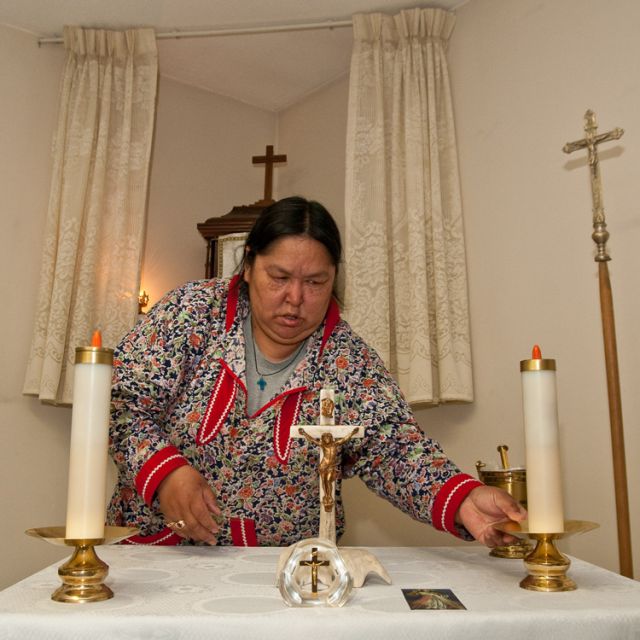Aboriginal peoples have a mystical connection with the land, we are reminded, and so of course they would stay. And the lure of quick riches will draw men to any place, no matter how crazy it might seem to those not suffering from gold fever. Then there are the missionaries — Oblates of Mary Immaculate — who voluntarily came up north to be a Catholic presence to a few hardy souls.
I had supper with one such Oblate, Fr. Pierre Rigaud. It was his 92nd birthday, so the conversation turned to his life story. In 1947, he came as a newly ordained priest from war-ravaged France. He told stories of survival in remote missions which required his confreres to be true pioneers, getting about by dogsled, constructing their own buildings by hand, tending to both the material and spiritual needs of congregations of a few dozen at most. It is the story of the northern missions — heroic, sacrificial devotion to serve very, very few.
Does it still make sense to do that, now that the Oblates have largely died out?
In strict numbers, there is a certain madness to it all. The 11,000 Catholics in the entire Yukon would not constitute a large parish in Toronto, to say nothing of Manila or Guadalajara. Why devote heroic resources to serve, in a limited way, places where the traces of the faith are faint indeed? Bishop Gary Gordon and his few priests drive thousands of kilometres to offer Mass intermittently in missions to a handful of the faithful here, five or six there, perhaps a dozen on a good day. It is admirable. But is it the way forward?
Whitehorse has two parishes, and more than two-thirds of the Yukon’s Catholics live here. There is a Catholic high school with 400 students, and two Catholic elementary schools. Madonna House has a presence here too. To a visiting priest on a first visit, the thought occurs that the bishop might exchange his endless days on the road for a more or less constant evangelizing presence in Whitehorse itself.
Bishop Gordon is a gifted evangelist, so if he were to focus his energies here, along with one or two priests, it would be a shift from a vast territory thinly served to a small city rather intensively served. The price would be the practical abandonment of the far-flung missions. Is that a valid evangelical tradeoff? Perhaps, as the evangelization of souls first requires that there be souls to evangelize, and they are lacking in the rest of the Yukon.
Yukoners who know better than I do will answer those questions better than I can. But it is a question too for many Canadian dioceses.
Many of our cities have parishes with dying congregations served by a dwindling clergy. They are evangelically dead, and have been for some time.
The case is even more evident in rural dioceses, where population shifts have compounded the problem of secularization to empty both the villages and churches of young people.
Should heroic sacrifices be made to preserve for as long as possible the structures as they used to be, or is it better to devote personnel and resources to the demands of the new evangelization — youth, campus ministry, the marriage and family apostolate? I tend to think that it is, but have no illusions about the pain it would cause.
The bishop who closed a cluster of parishes in order to devote that priest and those resources instead to a program of evangelization for newly married couples and young families would not be literally crucified, but he might feel like he had been.
It is always easier to try to continue on as before, but authentic missionary work is never easy. Just ask the missionaries who went north generations ago.
Are northern efforts coming at the expense of the new evangelization?
By Fr. Raymond J. de SouzaWHITEHORSE, YT - Last week I wrote about my impressions of the Yukon on my first trip to Canada’s north. In many ways it is altogether different from anything I have previously encountered in Canada’s cities, or even in my parish on Wolfe Island. At the same time the Yukon raises questions that the Church in all of Canada must face.
It is frankly astonishing that anyone lives in some of these remote communities, where a summer visitor is impressed by the natural beauty but year-round residents have to cope with isolation and lack of services, to say nothing of the severe cold and oppressive darkness of the punishing winter. To imagine living up here in the early 20th century, before roads and four-wheel drive trucks and propane gas heating and food preservatives is mindboggling, especially given that an overland trek of several weeks would deliver one into the Okanagan, one of the loveliest climates anywhere in the world.
Please support The Catholic Register
Unlike many media companies, The Catholic Register has never charged readers for access to the news and information on our website. We want to keep our award-winning journalism as widely available as possible. But we need your help.
For more than 125 years, The Register has been a trusted source of faith-based journalism. By making even a small donation you help ensure our future as an important voice in the Catholic Church. If you support the mission of Catholic journalism, please donate today. Thank you.
DONATE

